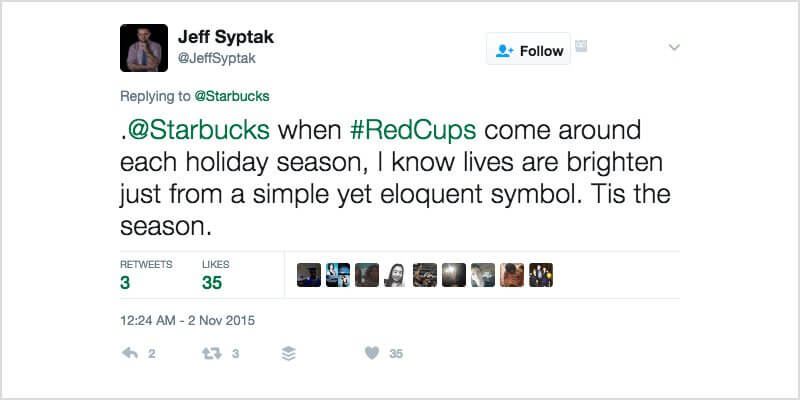5 Lessons the Starbucks Red Cup Controversy Taught Us
Is a cup just a cup? Most people think so.
But for business and brand building, we stand to learn a lot from the Starbucks red cup marketing controversy.
The folks at Starbucks were likely only thinking about gorgeous, minimalistic design during the process of planning their holiday cup in 2015.
Therefore, it is possible they were a bit confused when a small group of critics decided to create an uproar over the Starbucks cup.
Let’s start with the backstory.

Source: Starbucks
What is the Starbucks Red Cup Controversy?
Touted by some as a “War on Christmas”, people declared they were boycotting Starbucks because the cups did not contain any Christmas-related messaging. They adopted the hashtag #MerryChristmasStarbucks and took their protest to social media.
Cue the backlash.
Deemed #Cupgate2015, the Starbucks red cup hashtag #starbucksredcup took off on Twitter—along with #getoverit and #itsjustacup.
Yes, you’re reading this right: Starbucks red cup campaign created repercussions most sane folks can’t begin to imagine.
If you thought all of this red Starbucks cup controversy was over by now—you were mistaken.
In rolls the 2016 holiday season, and what does Starbucks decide to introduce?
A new green cup.

Source: Business Insider
Now consumers no longer had minimalistic red cups to complain about.
They didn’t have red at all.
The green cup was not a symbol of the holidays but instead featured images of people intertwined to symbolize unity. Starbucks stated the new green cup, “represents the connections we have as a community, it’s meant to be a symbol of unity, and encourage us to be good to each other.”
The green cups were a bold message.
However, they were not a blatant holiday message. Nor were they the classic red holiday cup, and so it seriously enraged some consumers.
Another onslaught of social media postings and brand mentions were plastered across the news. Tweets rolled in saying #TeamRedCup and #boycottstarbucks.
Funny how only a year prior, the red Starbucks cup controversy was raging. Upon introduction of the green cup, lots of folks decided it wasn’t so bad after all.
Simply put, Starbucks was not going to come out a winner in everyone’s eyes, no matter what the cup looked like.
By 2016, it was all but guaranteed they knew redesigning the cup would cause an uproar—and they welcomed it with open arms.
What started as just a design change for Starbucks has resulted in more mentions and publicity around the feelings, emotions and viewpoints of beverage lovers across the world.
As a business owner, there is always something to learn. What are the biggest takeaways for a business from the Starbucks cup controversy?
Take a look at what we came up with.

BONUS: Get our guide to building a brand identity, where everybody knows your name.
Important Lessons Learned from the Red Starbucks Cup Controversy
1. Bad PR is not always so bad.
During each cup controversy, pictures of people holding their red and green cups flooded social media. What’s more, they touted pro-Starbucks hashtags like #ItsJustACup.
While the famous saying, “All press is good press,” is not totally true (here’s lookin’ at you United Airlines), in the case of the Starbucks red cup controversy, it was all good press.
Even when a user shared a #boycottstarbucks post, they were doing it over the color of a cup, not the kind of heinous act it typically takes to influence a large number people to stop consuming an incredibly popular brand.
All these naysayers really did was bring valuable attention to the Starbucks brand, guaranteeing an uptick in sales. And boy, was Starbucks ready for their close up!
This Starbucks red cup controversy also led to mentions from notable influencers such as Ellen Degeneres and Donald Trump.
Ellen made a joke of the red cup on her show saying, “People are mad about this cup, because they’re saying Starbucks is being anti-Christmas. The old cups had snowflakes and Santa’s sleigh and elves. You know, all the things you find in the Bible.”
On the other side of things, Donald Trump said, “If I become president, we’re all going to be saying ‘Merry Christmas’ again. That I can tell you.”
It seemed like everyone had an opinion. And every opinion included the brand name Starbucks. No matter which “side” prevailed, there was clearly a winner in all of this –
Starbucks.
Mentions of #starbucks spiked across social media as people weighed in on both sides of the argument.
Especially now, the power of social media is immense. It took no time at all for the red and green cups to take over consumers’ news feeds.
Try to embrace all mentions of your brand, good or bad. You can never, ever please everyone. So, in the event you find yourself in a true Kendall-Jenner-Pepsi-Gate, focus on the positives!
Bad PR is not always so bad, if you leverage and focus on the positives.
2. Stick to your brand values.
Starbucks chose not to address the situation head on, and instead kept their message focused on the positive meaning of their cups.
During the original red Starbucks cup controversy, the company released the statement, “Creating a culture of belonging, inclusion and diversity is one of the core values of Starbucks, and each year during the holidays the company aims to bring customers an experience that inspires the spirit of the season. Starbucks will continue to embrace and welcome customers from all backgrounds and religions in our stores around the world.”
While this inclusive message did not fully appease their die-hard “Christmas Cup Lovers”, it certainly reiterated what Starbucks stands for.
What does your company stand for?
How does your product or service promote those brand values?
Sustain your brand building process by keeping true to the message your particular branding supports.
Notice how Starbucks’ statement managed to avoid responding to any negativity while still clearly touching on the controversy.
This tactic essentially says, “We hear you, but we aren’t going to allow your negativity to affect our brand message in any way.”
It is incredibly important to acknowledge a situation like this without “buying-into” the controversy.
It can be hard not to jump to the defensive, but a professional company will lean on their core brand values to ensure they can get to the other side of the bump in the road gracefully.
Moral of the story: Make sure your cooler heads prevail. There is never a situation in which a professional company should get their hands dirty with negative PR. Rising above isn’t always easy, but it is always necessary.
Stick to your brand values and keep a positive message when dealing with a controversy.
3. Be good at what you do.
Starbucks’ sales didn’t flinch during all of these controversies; in fact they grew.
The beloved Starbucks brand didn’t have to say a thing. Their loyal customers were ready to fight back on their behalf.

Source: Twitter
How did they inspire such brand evangelists? They are excellent at what they do, of course.
When you focus on providing quality products and services, and support them with great customer care, it is inevitable that your company will foster loyalty among your consumers.
In Starbucks’ case, they spent years and years being the top dog when it comes to coffee. When a brand is sitting that pretty, a little cup controversy is nothing to worry about.
In most cases though, a company who finds themselves in a PR controversy likely won’t have Starbucks-sized klout. Cultivating loyal brand ambassadors is even more important for “the little guys”.
How do you build brand advocacy when you are small, or new, or both?
If you can answer, “Yes” to the questions below, you are on the right track.
Do you:
- Provide the utmost care and quality regarding your products/services?
- Treat every customer with respect?
- Spend time replying to your online reviews (good and bad)?
- Invest time in social media to further connect with your core customer group?
- Work hard to make a negative customer experience into a positive one?
All in all, it’s quite simple. Go be excellent within your niche.
Be good at what you do, and your loyal customers will become brand advocates.
4. Prepare for some consumer resistance.
People don’t like change, it is a historically known fact.
The red Starbucks cup controversy taught us that if people are used to their Starbucks cups with Christmas-related designs on it, they will be upset with anything different. Swapping the snowflakes for a Christmas Tree would have likely caused just as much uproar, trust us.
This does not mean you should shy away from change!
Being different is what makes your brand and company yours.
As long as you’re aware of the fact that any change will result in some level of resistance, you’ll be better prepared to preempt resistance with a gradual announcement that doesn’t “shock” your audience.
Effective use of social media for customer service can really help in this arena.
Knowing you may be on the receiving end of some angry fans gives you an opportunity to prepare responses in advance.
Predetermined responses are great as long as you take the time to modify them on a case-by-case basis. In other words, prepare on-brand messaging that you and your team can easily tweak to fit unique situations.
5. Always have a plan.
After the first red Starbucks cup controversy, the brand realized they had inadvertently (or purposely, we’ll never know) unearthed a gold mine.
They didn’t get nervous and switch back to their old design. They adapted and created a new strategic plan (check out our roadmap for building your own Marketing Strategy). That plan involved revving up the PR engine with even more cup “controversy”.
This Spring Starbucks just released a new Spring Cup line with pastel colors and designs of flowers, bunnies, and sunshine.
The doodles are very nondescript as you can see here.

Source: Cosmopolitan
The cups have absolutely nothing to do with Easter, but you’re right to assume the media sure thought they did.
It’s clear Starbucks will continue to gain a lot of press with a little effort while welcoming the criticism! Is the word “Genius” coming to mind? We thought so.
Starbucks effectively took a rainy day and turned it into sunshine (hmm…inspiration for the Spring Cup Line perhaps?) by staying true to their brand and embracing varying opinions.
If critics were vocal about one of your business decisions, how would you handle it? Consider how you’ll answer – or not answer – critics on social media and elsewhere.
Knowing this is a significant part of the battle.
SEE ALSO: 3 Simple Steps for a Strategic Marketing Planning Process
Conclusion
Although each controversy over Starbucks red cup began with negative feedback, they were definite wins for Starbucks. Without saying much, they found themselves in the midst of a series of successful campaigns–and all they did was release a new cup.
If you’re a marketing professional, you can probably envision the hours and hours of strategy and design meetings it took Starbucks and their creative agency to get to the new cup design.
Plus, we know they debated over whether “poking the bear” with a second cup design was the right idea. But to the general public, this comes off as a small campaign with a big impact–and that’s priceless.
Consider how even a massive brand like Starbucks can do “a little” and end up with a lot. When it comes to your business, the big take away here is finding ways to create an impact without creating endless work.
These impacts are usually rooted in change.
In other words, you don’t need a million dollar budget and a year of effort to make waves.
Think about the kinds of things you can change for the better. Remember, not everyone is going to agree that it’s better, but that is okay. As long as you truly believe the change makes your company, product, or service better in some way, it’s worth doing.
We have certainly learned a lot from the red starbucks cup controversy. Remember these key lessons:
- Bad PR is not always so bad.
- Stick to your brand values.
- Be good at what you do.
- Prepare for some consumer resistance.
- Always have a plan.
What else can marketers learn from the red Starbucks cup controversy?
Let us know what you think in the comments below!

BONUS: Get our guide to building a brand identity, where everybody knows your name.
If you like this article, please share!




